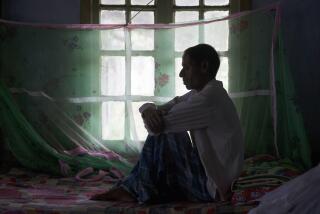We Can Beat TB, if We Act in Concert
- Share via
What would Americans say if they learned of a disease so easily transmitted that you could catch it by sitting in the same airplane as someone who has it? A disease so deadly that it killed more than 2 million people around the world last year, 50,000 of them in the Americas alone? A disease that used to be easily treatable but which has progressively grown resistant to the drugs available to fight it? A disease that can lie in wait inside your body for decades and then break out and ravage your health when you are at your most vulnerable?
Given current concerns about new threats to U.S. national security, perhaps you might think that this was a new biological warfare agent. In fact, the war that is being waged is not by another nation but by one of the oldest and most tenacious enemies of humankind.
The disease we are describing is tuberculosis and it is a leading threat to health throughout this hemisphere. Last year, more than 19,000 people came down with this disease in the U.S.--more than 4,000 in California. But this is a threat we have the know-how and the resources to beat if only we choose to use them.
Today is World TB Day, and the Pan American Health Organization, along with the World Health Organization and in partnership with federal and state health agencies and a broad alliance of nongovernmental organizations, is taking a stand against TB. We are not alone.
From Peru to Nicaragua, national governments have substantially increased their support for anti-TB measures, and we have started to roll back the deadly tide. Here in the U.S., thanks to concerted action, cases are down more than 25% from their high point in 1992. But we have a long way to go.
What has made this challenge imaginable has been the development of a new strategy called Directly Observed Therapy-Short course. DOTS involves administering effective drugs to people who have TB over the course of six months, and having a health provider (usually a nurse or paramedical worker) watch the patient swallow the pills. DOTS has shown cure rates of more than 90%, even in the poorest settings. It is nearly a miracle and an incredibly cost-effective strategy. The cost of the drugs for DOTS is less than $40. The cost of treating a single case of TB that has gotten out of control and developed resistance to multiple drugs can exceed $100,000.
If we treat only the tip of the iceberg--the U.S. cases--without addressing the ongoing source of new infections throughout the poorer areas of the hemisphere, we will always be playing catch-up. In Latin America and the Caribbean, 24 countries have now launched DOTS. Public health action in communities effects change, but national backing often makes the difference.
It is cheaper, more effective and ultimately more humane to fight TB in other countries, thereby eliminating the continued spread of this disease. This also will directly fight one of the main sources of persistent poverty in our hemisphere: Since TB most often strikes adults under 50 and makes them too sick too work, it has an enormous economic impact on families and the entire society.






